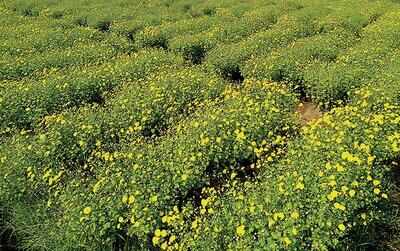
Udupi: Growers of Hemmady’s famed sevanthige are demanding compensation from the government as a short winter this year delayed yield and now that the flowers are ready for plucking, demand has dipped. The horticulture department, however, says it is helpless: compensation can be given only if there is crop damage or loss.
The village of Hemmady, in Kundapur taluk, is known for its distinctive yellow chrysanthemum, deep yellow and fragrant and grown traditionally without use of chemicals. But while the Mattu Gulla (green brinjal) from Mattu Katpady has been patented, Hemmady’s sevanthige remains unmarked.
The flowers is cultivated on over 500 acres in the village, mostly on small plots and leased ones. Several families have grown the chrysanthemum for generations now and depend on its yield, which peaks between November and February.
“The demand for the flowers surges in January as many local religious festivals — genda, dhakkebali, Brahmamandala and the famous Makara Sankramana at Marnakatte — begin at this time. The sevanthige is an integral part of religious beliefs and celebrations here and we sell our entire yield locally. We either sell it directly to customers or make garlands and supply to local shops,” said Mahabala Devadiga, a farmer.
“This year, there were no flowers in January due to a decrease in temperature. Over the past two weeks, we are able to harvest the flowers but the festival season is over and the demand has dipped,” he said.
Farmers also blamed mite disease for damaging a substantial portion of the crop, a recurrent phenomenon for which no solution has been found. Mite attacks prevent buds from blossoming and cause flowers to wilt soon after they are plucked. “The medicine and pesticides given by the agriculture and horticulture department are ineffective. We have incurred a huge loss,” Devadiga said.
The deputy director of horticulture, Bhuvaneshwari, said the department could not compensate farmers for seasonal fluctuations. “If floods or drought affects the crop, compensation can be given. For the past two years, we have been giving subsidy under ‘crop area expansion’ scheme but that cannot be given repeatedly to one farmer or one survey number. We are helpless,” she said.
As the fields turn a vivid yellow, belatedly, farmers say their future is bleak. “My family has been growing sevanthige in Hemmady for three generations but I have seen the number of farmers dwindling because there is no support from the government. I have spent 50 years in sevanthige fields and so have a large number of families here who are entirely dependent on the income generated by the flower,” Devadiga said. “We have a Sevanthi Belagagara Sangha, comprising 52 farmers. We hope the government listens to us.”
Besides the challenges at home, the Hemmady sevanthige is having to contend with cheaper hybrid flowers that are flooding the markets from different parts of the state. Since the Hemmady chrysanthemum is grown traditionally, it is smaller and costlier compared to the hybrid ones. “For the past two years, the horticulture department has been providing a meagre amount of Rs 6,000 per acre and there is no other support,” Devadiga said.
The village of Hemmady, in Kundapur taluk, is known for its distinctive yellow chrysanthemum, deep yellow and fragrant and grown traditionally without use of chemicals. But while the Mattu Gulla (green brinjal) from Mattu Katpady has been patented, Hemmady’s sevanthige remains unmarked.
The flowers is cultivated on over 500 acres in the village, mostly on small plots and leased ones. Several families have grown the chrysanthemum for generations now and depend on its yield, which peaks between November and February.
“The demand for the flowers surges in January as many local religious festivals — genda, dhakkebali, Brahmamandala and the famous Makara Sankramana at Marnakatte — begin at this time. The sevanthige is an integral part of religious beliefs and celebrations here and we sell our entire yield locally. We either sell it directly to customers or make garlands and supply to local shops,” said Mahabala Devadiga, a farmer.
“This year, there were no flowers in January due to a decrease in temperature. Over the past two weeks, we are able to harvest the flowers but the festival season is over and the demand has dipped,” he said.
Farmers also blamed mite disease for damaging a substantial portion of the crop, a recurrent phenomenon for which no solution has been found. Mite attacks prevent buds from blossoming and cause flowers to wilt soon after they are plucked. “The medicine and pesticides given by the agriculture and horticulture department are ineffective. We have incurred a huge loss,” Devadiga said.
The deputy director of horticulture, Bhuvaneshwari, said the department could not compensate farmers for seasonal fluctuations. “If floods or drought affects the crop, compensation can be given. For the past two years, we have been giving subsidy under ‘crop area expansion’ scheme but that cannot be given repeatedly to one farmer or one survey number. We are helpless,” she said.
As the fields turn a vivid yellow, belatedly, farmers say their future is bleak. “My family has been growing sevanthige in Hemmady for three generations but I have seen the number of farmers dwindling because there is no support from the government. I have spent 50 years in sevanthige fields and so have a large number of families here who are entirely dependent on the income generated by the flower,” Devadiga said. “We have a Sevanthi Belagagara Sangha, comprising 52 farmers. We hope the government listens to us.”
Besides the challenges at home, the Hemmady sevanthige is having to contend with cheaper hybrid flowers that are flooding the markets from different parts of the state. Since the Hemmady chrysanthemum is grown traditionally, it is smaller and costlier compared to the hybrid ones. “For the past two years, the horticulture department has been providing a meagre amount of Rs 6,000 per acre and there is no other support,” Devadiga said.
Trending Topics
LATEST VIDEOS
City
 Bhuj sect's Swami stirs controversy, says 'If menstruating women cook food, they will be born as bitch in next life'
Bhuj sect's Swami stirs controversy, says 'If menstruating women cook food, they will be born as bitch in next life'  30 kg gold looted in Ludhiana, robbers caught on camera
30 kg gold looted in Ludhiana, robbers caught on camera  Jamia student files case against Delhi police, seek Rs 1 crore as compensation
Jamia student files case against Delhi police, seek Rs 1 crore as compensation  Mangaluru restaurant offers complementary biryani to blood donors
Mangaluru restaurant offers complementary biryani to blood donors
More from TOI
Navbharat Times
Featured Today in Travel
Get the app



